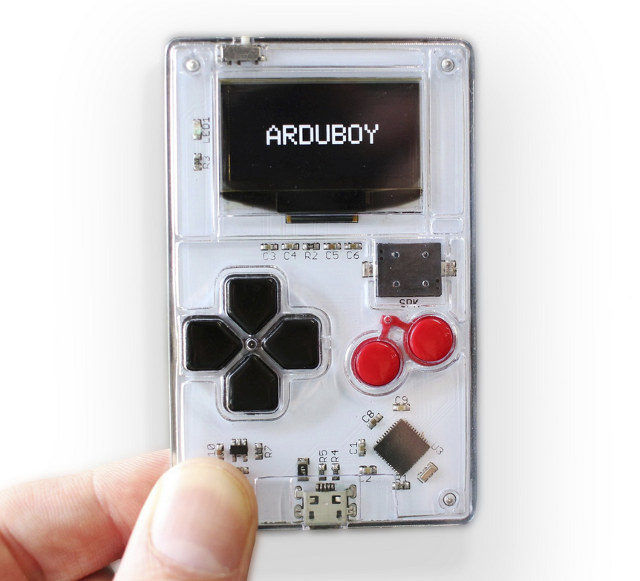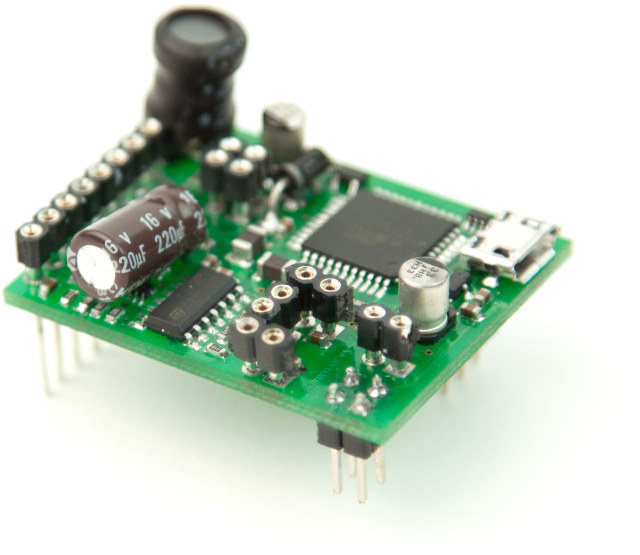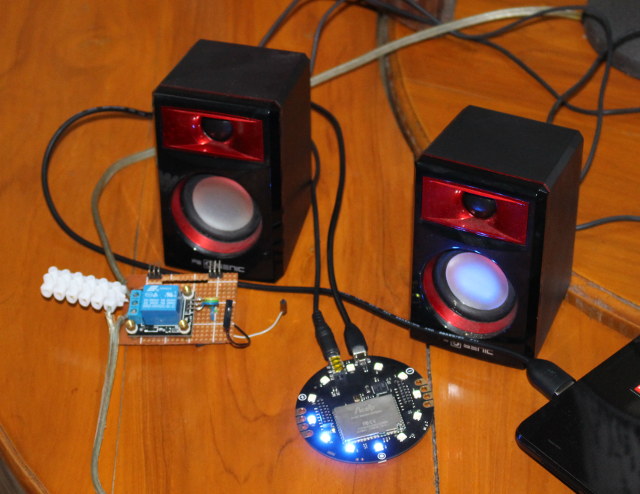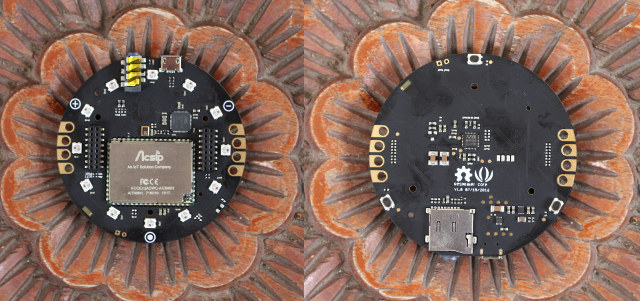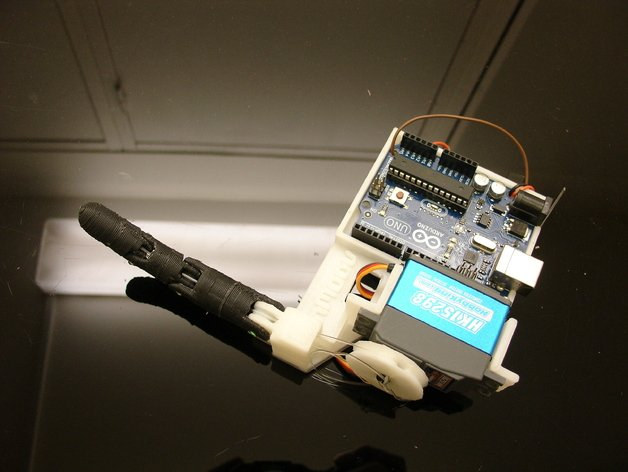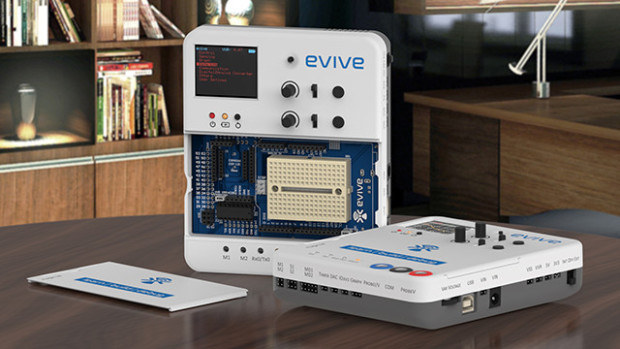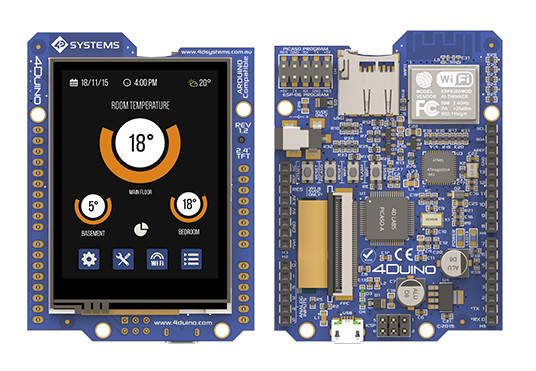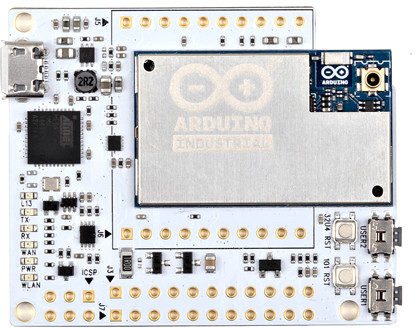Ardubox feels like the little brother of PocketCHIP portable & hackable game console with its transparent case, but instead of running Linux on a 32-bit ARM processor, Ardubox is based on the same Atmel ATmega32u4 MCU used in Arduino Leonardo & Micro boards. Arduboy specifications: MCU – Atmel ATmega32u4 AVR MCU with 32KB flash, 2.5KB RAM, and 1KB EEPROM Display – 128×64 1-bit OLED display USB – 1x micro USB 2.0 port for power and programming User Inputs – 6x momentary tactile buttons Audio – 2 channel Piezo Speaker Misc – 1x LED Battery – 180 mAh Thin-Film Li-Po battery good for over 8 hours Beside the Arduino IDE, The board can also be programmed with Codebender, GCC & AVRDude. There’s also a fairly long list of games to play with, and it can be hacked as a virtual business card, a USB mouse and keyboard, a synthesizer, and more. […]
Espotek Labrador is s $25 5-in-1 Lab-on-a-Board with Oscilloscope, Waveform Generator, etc… (Crowdfunding)
We’ve already seen ultra cheap (and low end) electronics lab tools like DSO138 oscilloscope kit for $23, or the $5 USB123 USBee AX logic Analyzer, but EspoTek Labrador combines 5 electronics lab equipments into a single board that claims to act as an oscilloscope, a waveform generator, a variable power supply, a logic analyzer and a multimeter for just $25. EspoTek Labrador specifications and key features: MCU – Atmel ATXMEGA32A4U 8-bit AVR MCU @ 32 MHz with 32KB flash, 4KB SRAM, and 1024 bytes EEPROM Functions 2 channels oscilloscope up to 750ksps, ~100kHz bandwidth, -20 to +20 V range 2 channels waveform generator up to 1 MSPS supporting sinusoidal, square, triangular, sawtooth, and arbitrary waveforms 4.5 to 15V power supply up to 1.5W max 2 channels logic analyzer up to 3 MSPS per channels Multimeter with voltage, intensity, resistance, and capacitance functions USB – micro USB port to connect to […]
Getting Started with ReSpeaker WiFi IoT Board’s Audio Capabilities, Voice Recognition and Synthesis
ReSpeaker is a development board combining an Atmel AVR MCU, a MediaTek MT7688 WiFi module running OpenWrt, a built-in microphone, an audio jack, and I/O headers to allow for voice control and output for IoT applications. That means you could make your own Amazon Echo like device with the board and add-ons, use it as a voice controlled home automation gateway and more. The board was launched on Kickstarter a few days ago, and already raised $100,000 from about 100 backers, but I’ve received an early sample, so I’ll provide some more information about the firmware, and shows how to use with some Python scripts leveraging Microsoft Bing Speech API. You’ll need a micro USB to USB cable to connect your to computer (Linux, Windows, Mac OS…), and a speaker to connect to the board. Linux (OpenWrt) boots in a few seconds, and once it’s done all RGB LED will […]
ReSpeaker WiFi IoT Board is Designed for Voice Interaction (Crowdfunding)
More and more devices are supporting voice interaction nowadays from your smartphone to devices like Amazon Echo, but so far, I had not seen development boards specifically designed for that purpose, and that’s exactly what Seeed Studio ReSpeaker board does by combining audio capabilities, WiFi connectivity, and I/O headers. ReSpeaker Core board specifications: WiFi Module – Acsip AI7688 Wi-Fi 802.11 b/g/n module based on Mediatek MT7688 MIPS SoC Storage – micro SD card slot USB – 1x micro USB port for programming and power Audio – 3.5mm AUX port, WM8960 audio codec, 2-pin header for external speakers Expansion – 2x 8-pin expansion headers for I2C, GPIO and USB 2.0 host connected to MT7688, built-in microphone. MCU – Atmel ATMega32U4 @ 16 MHz Misc – 12x RGB LEDs, 8x touch sensors, 3 push buttons Power Supply – 5V DC Dimensions – 70mm diameter Weight – 70 grams The board runs OpenWrt, […]
Learn the Basics of Humanoid Robots with InMoov Finger Starter Kit
In a not so distant future, most humans will live off their government provided basic income, relaxing and drinking their robot brewed, drone delivered beer or soda, opened and served by their humanoid robot maid. Well, maybe… In the meantime, it might be interesting to learn how to make humanoid robots such as InMoov, but since it’s quite complicated, it might be better to start small… with a single finger. That’s exactly what InMoov Finger Starter Kit offers you to do in order to understand the basics principles of the complete robot. The kit includes: 1x 3D printed base support in ABS 3D printed finger parts in ABS 1 meter braided 200 LB tendon 1x 5cm filament for peg/pin use to assemble finger joints 1x wheel horn adapter (Servo Pulley) 4x screws to fix the servo to the base support. You’ll also need to provide your own Arduino Uno (or […]
Evive is an Arduino Compatible Platform with Enclosure, Lots of I/Os, Buttons, and an 1.8″ Display (Crowdfunding)
Engineers at Agilo Technologies, an Indian startup based in Kanpur, Uttar Pradesh, felt that the wire mess often produced while learning or prototyping with Arduino boards could be an issue, and it was easy to mis-wire your setup, so they’ve decided to create a user and student friendly Arduino compatible system with many of the items you’d normally use with Arduino board such as buttons, probes inputs, an 1.8″ color display, headers for ESP8266, Bluetooth, and XBEE moduels, etc.. and all of that enclosed in a neat case. Evive was born. Evive specifications: MCU – Atmel ATmega2560 8-bit AVR MCU @ 16 MHz with 256KB flash, 4KB EEPROM, 8KB SRAM Storage – micro SD slot up to 32GB Display – 1.8″ TFT display; 160×128 resolution; 18-bit color User inputs – Tactile and slide switches, joysticks, and potentiometers Probes inputs – Voltage / Intensity sensing inputs USB – USB device port Expansion Headers […]
4Duino-24 is an Arduino compatible 2.4″ Color IoT Display Module with Atmel MCU and ESP8266 Module
I played with ITEAD Studio NEXTION serial color displays for Arduino boards and the likes a few months ago, and while the hardware seems good and the company offer a large choice of 2.4″ to 7″ models at a very affordable price, I didn’t find the Windows software to create the user interface to be very user-friendly. 4D Systems, an Australian company specializing in “graphics solutions”, will soon launch a similar 2.4″ display, but integrated into an Arduino compatible board also featuring an ESP8266 module for WiFi connectivity. 4Duino-24 “LCD IoT Display Module” specifications: MCU – Atmel ATmega32U4 micro-controller with 32KB flash, 2.5KB SRAM, 1KB EEPROM Storage – micro SD card slot (FAT16 support) for data and logging WiFi Module – ESP8266 based with 802.11 b/g/n connectivity, 1MB flash, support for Wi-Fi Direct (P2P), soft-AP Display – 2.4” LCD-TFT resistive touch display module with 240×320 resolution, 65K colors, and powered […]
Arduino Industrial 101 Board Powered by Atmel AVR and Atheros AR9331 WiSoC Targets Industrial IoT Applications
Arduino boards were first used by hobbyists, educators and their students, but in recent year more and more professional engineers have started to build prototypes with Arduino boards before moving to the design of the final product. Arduino Srl went further by designing an industrial grade board, namely Arduino Industrial 101, combining an Atmel AVR for real-time I/O control, and a Qualcomm Atheros AR9331 for WiFi connectivity. Arduino Industrial 101 (A000126) specifications: Arduino part MCU – Atmel ATmega32u4 AVR MCU @ 16 MHz with 32KB flash, 2.5 KB SRAM, 1KB EEPROM Digital I/O Pin – 20, with 7 PWM and UART Analog Input Pins – 12 DC Current per I/0 – 40 mA Operating Voltage – 5V Linux (LininoOS) part (101 Industrial LGA “Chiwawa” module) Processor – Atheros AR9331 MIPS processor @ 400 MHz System Memory – 64 MB DDR2 Storege – 16 MB flash WiFi – 802.11 b/g/n […]


